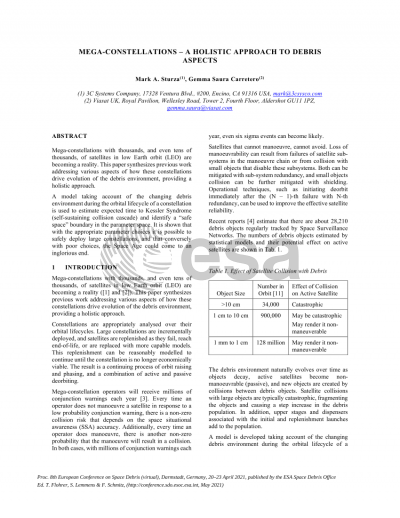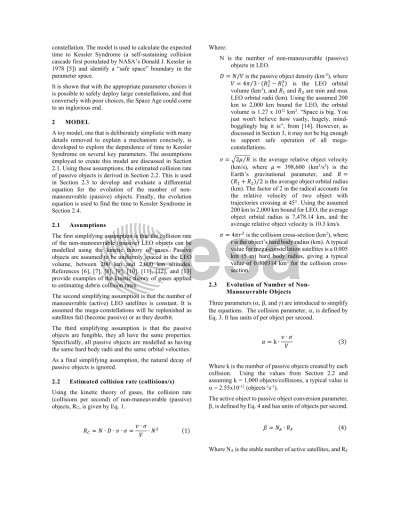Document details

Abstract
Mega-constellations with thousands, and even tens of thousands, of satellites in low Earth orbit (LEO) are becoming a reality. This paper synthesizes previous work addressing various aspects of how these constellations drive evolution of the debris environment, providing a holistic approach.
Constellations are appropriately analyzed over their orbital lifecycles. Large constellations are incrementally deployed and satellites are replenished as they fail, reach end-of-life, or are replaced with more capable models. This replenishment can be reasonably modeled to continue until the constellation is no longer economically viable. The result is a continuing process of orbit raising and phasing, and a combination of active and passive deorbiting.
Every time a satellite is not maneuvered in response to a low probability conjunction warning, there is a non-zero collision risk that depends on the space situational awareness (SSA) accuracy. Additionally, every time a satellite is maneuvered, there is another non-zero probability that the maneuver will result in a collision. In both cases, with a sufficient number of conjunctions occurring, even six sigma events can become likely.
Satellites that cannot maneuver, cannot avoid. Loss of maneuverability can result from failures of satellite sub-systems in the maneuver chain or from collision with small objects that disable these subsystems. Both can be mitigated with sub-system redundancy, and small objects collision can be further mitigated with shielding. Operational techniques, such as initiating deorbit immediately after the (N – 1)-th failure with N-th redundancy, can be used to improve the effectively satellite reliability.
The debris environment naturally evolves over time as objects decay and new objects are created by collisions between debris objects. Satellite collisions with large objects are typically catastrophic, fragmenting the objects and causing a step increase in the debris population. In addition, upper stages and dispensers associated with the initial and replenishment launches add to the population.
A Markov model is developed taking account of the changing debris environment during the orbital lifecycle of a constellation. Monte Carlo simulations of the model are used to calculate mean-time to Kessler Syndrome (self-sustaining collision cascade) and identify a “safe space” boundary in the parameter space. It is shown that with the appropriate parameter choices (numbers of constellations, numbers of satellites in each, orbits, satellite design, operational practices, SSA accuracy, and debris removal) it is possible to safely deploy large constellations, and that conversely with poor choices, the Space Age could come to an inglorious end.
Preview





